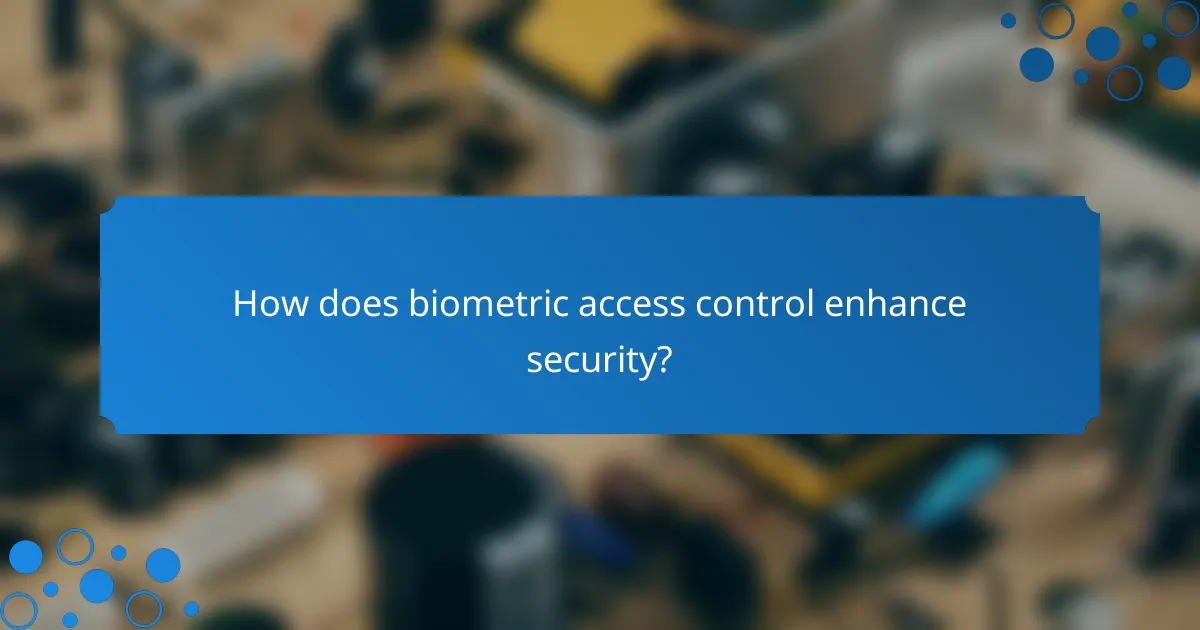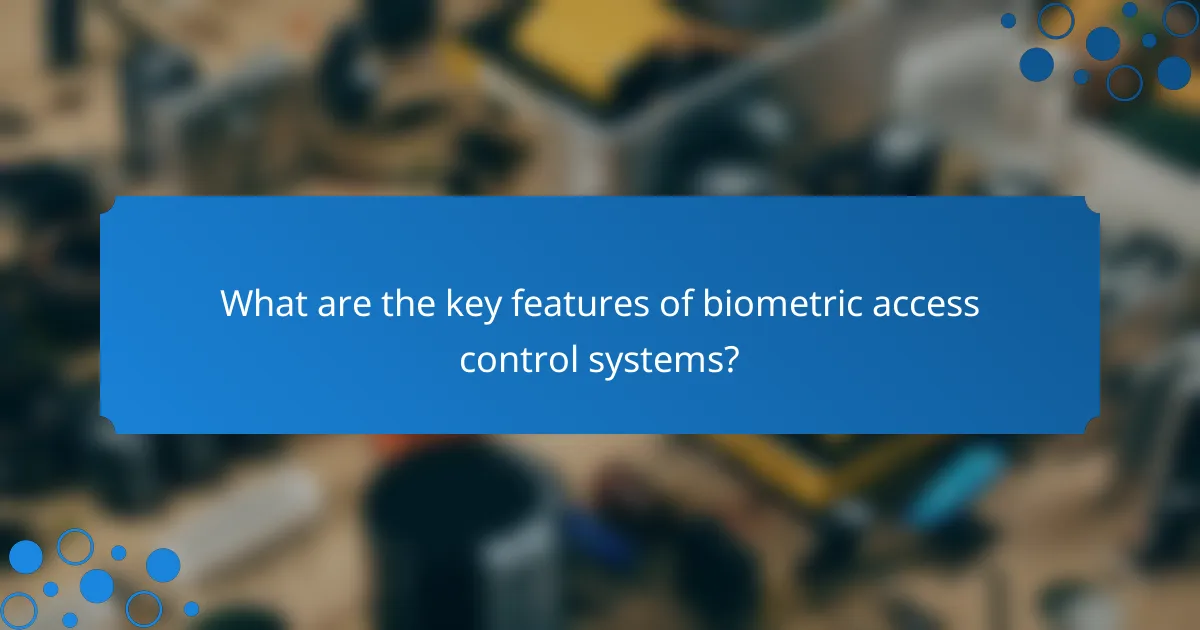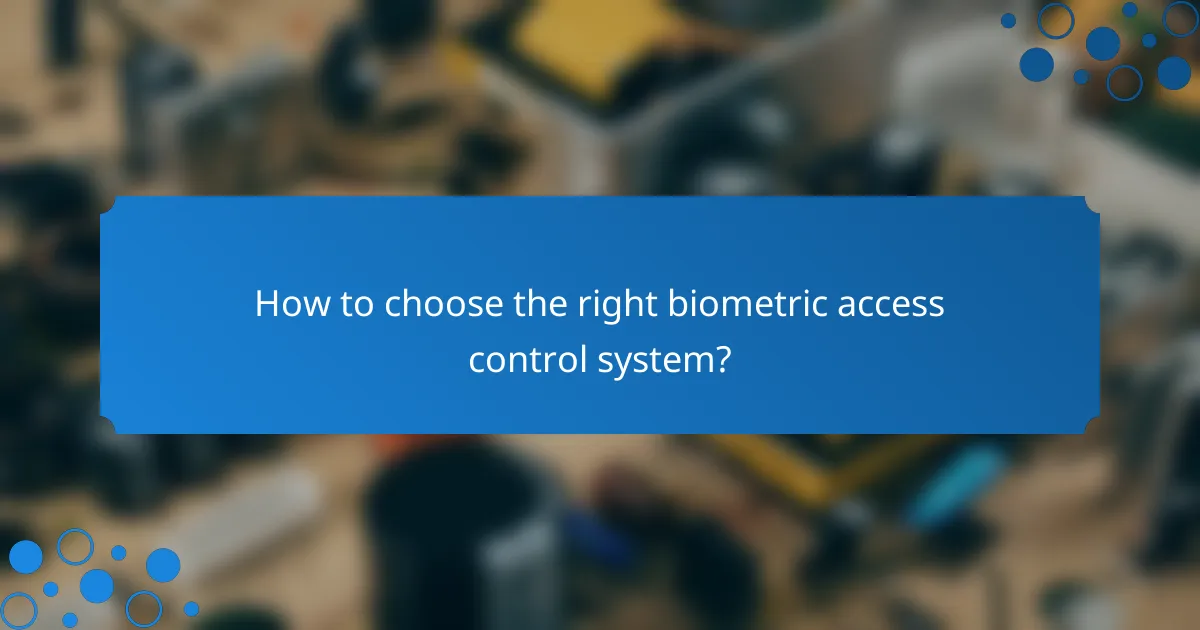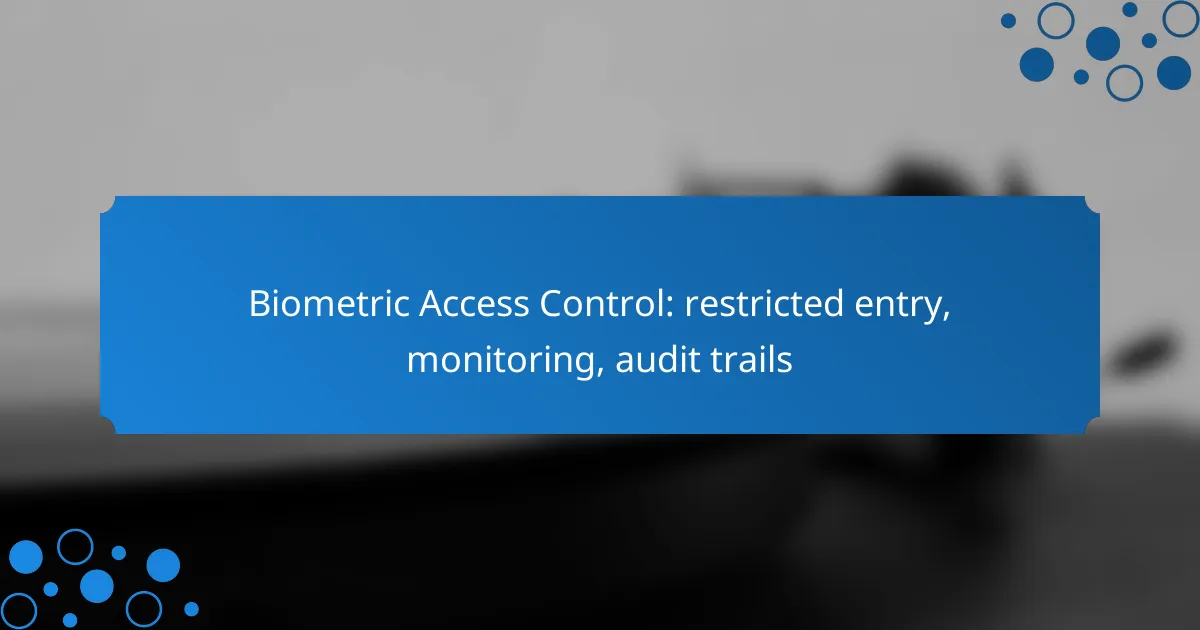Biometric access control systems utilize unique biological traits, such as fingerprints and facial recognition, to restrict entry and enhance security. By ensuring that only authorized individuals can access restricted areas, these technologies provide robust monitoring and generate detailed audit trails for accountability. This integration of advanced biometric solutions significantly strengthens overall security protocols.

What are the best biometric access control solutions in Canada?
The best biometric access control solutions in Canada include fingerprint recognition, facial recognition, iris scanning, voice recognition, and mobile biometric authentication. These technologies enhance security by ensuring that only authorized individuals can gain access to restricted areas while providing monitoring and audit trails for accountability.
Fingerprint recognition systems
Fingerprint recognition systems capture and analyze the unique patterns of an individual’s fingerprints. These systems are widely used due to their affordability and reliability, often featuring quick scanning times of a few seconds. However, they can be less effective in cases of dirty or damaged fingers.
When implementing fingerprint systems, consider the environment. High-traffic areas may require more durable devices, while smaller installations can use basic models. It’s essential to ensure compliance with Canadian privacy laws regarding biometric data storage and usage.
Facial recognition technology
Facial recognition technology uses algorithms to identify individuals based on facial features. This method is gaining popularity in Canada for its non-intrusive nature and ability to monitor multiple individuals simultaneously. However, accuracy can vary based on lighting conditions and angles.
For effective deployment, ensure that the system can integrate with existing security infrastructure. Be aware of privacy implications and ensure compliance with regulations like the Personal Information Protection and Electronic Documents Act (PIPEDA).
Iris scanning devices
Iris scanning devices analyze the unique patterns in the colored part of the eye. This technology offers high accuracy and security, making it suitable for sensitive areas. However, the cost of iris scanners can be significantly higher than other biometric solutions.
When considering iris scanning, evaluate the required level of security and the potential return on investment. Ensure that the devices are user-friendly and can accommodate individuals with varying eye conditions.
Voice recognition systems
Voice recognition systems authenticate users based on their unique vocal characteristics. These systems are convenient for remote access and can be integrated into various applications, such as phone systems and smart devices. However, background noise can affect performance.
For optimal results, consider using voice recognition in controlled environments. Regularly update the system to adapt to changes in users’ voices due to health or aging. Ensure that data privacy measures are in place to protect voiceprints.
Mobile biometric authentication
Mobile biometric authentication leverages smartphones and tablets to verify identity through biometrics like fingerprints or facial recognition. This solution is increasingly popular due to its convenience and the widespread use of mobile devices in Canada.
When implementing mobile biometric solutions, focus on user experience and security. Ensure that the applications are secure and comply with local regulations. Educate users on best practices for maintaining device security to prevent unauthorized access.

How does biometric access control enhance security?
Biometric access control enhances security by using unique physical characteristics to verify individual identities, making unauthorized entry significantly more difficult. This technology not only strengthens access protocols but also provides detailed monitoring and audit trails for accountability.
Unique identification of individuals
Biometric systems rely on distinct traits such as fingerprints, facial recognition, or iris patterns to identify individuals. These characteristics are unique to each person, making it nearly impossible to replicate or forge. For instance, fingerprint scanners can accurately match a person’s print within milliseconds, ensuring quick and reliable access.
Implementing biometric identification can streamline processes in various settings, from corporate offices to secure facilities. By integrating these systems, organizations can reduce the need for traditional access cards, which can be lost or stolen.
Reduction of unauthorized access
By utilizing biometric data, organizations can significantly reduce the risk of unauthorized access. Unlike passwords or access cards, biometric traits cannot be easily shared or stolen, providing a higher level of security. This is particularly crucial in sensitive environments such as data centers or government buildings.
Moreover, biometric systems can include multi-factor authentication, combining biometric verification with additional security measures. This layered approach further diminishes the chances of unauthorized entry, making it a robust solution for safeguarding assets.
Real-time monitoring capabilities
Biometric access control systems offer real-time monitoring, allowing organizations to track who enters and exits a facility at any given moment. This capability is essential for maintaining security and ensuring that only authorized personnel are present in restricted areas. Alerts can be generated for any unauthorized access attempts, providing immediate responses to potential threats.
Additionally, audit trails created by these systems can be invaluable for investigations or compliance purposes. Organizations can review access logs to identify patterns or anomalies, enhancing overall security management. Regular audits of these logs can help in identifying potential vulnerabilities and improving security protocols.

What are the key features of biometric access control systems?
Biometric access control systems utilize unique biological traits, such as fingerprints or facial recognition, to restrict entry and enhance security. Key features include audit trail generation, integration with existing security systems, and remote access management, all of which contribute to effective monitoring and accountability.
Audit trail generation
Audit trail generation is a critical feature of biometric access control systems that records every access attempt, successful or not. This data includes timestamps, user identification, and the specific entry points accessed, providing a comprehensive log for security reviews.
Organizations can use these audit trails to identify patterns of unauthorized access or to investigate security breaches. Regularly reviewing these logs can help improve security protocols and ensure compliance with regulatory standards.
Integration with existing security systems
Biometric access control systems can seamlessly integrate with existing security infrastructure, such as surveillance cameras and alarm systems. This integration enhances overall security by allowing for coordinated responses to security events.
When selecting a biometric system, ensure compatibility with current hardware and software to avoid costly upgrades. Look for systems that support common protocols, which can simplify the integration process and reduce implementation time.
Remote access management
Remote access management enables administrators to control and monitor access from anywhere, using secure internet connections. This feature is particularly useful for organizations with multiple locations or remote employees, allowing for real-time adjustments to access permissions.
Consider implementing multi-factor authentication alongside biometric systems for added security when managing remote access. Regularly update access permissions to reflect changes in personnel or organizational structure, ensuring that only authorized users retain access.

What are the compliance requirements for biometric access control in Canada?
In Canada, compliance requirements for biometric access control primarily involve adherence to privacy laws that govern the collection, use, and disclosure of personal information. Organizations must ensure that biometric data is handled in a manner that respects individuals’ privacy rights and complies with relevant regulations.
Personal Information Protection and Electronic Documents Act (PIPEDA)
PIPEDA is a federal law that sets the ground rules for how private sector organizations collect, use, and disclose personal information in the course of commercial activities. Under PIPEDA, biometric data is considered sensitive personal information, requiring organizations to obtain explicit consent from individuals before collecting or using their biometric identifiers.
Organizations must also implement adequate security measures to protect biometric data and ensure it is only used for the purposes for which consent was granted. Regular audits and assessments of data handling practices are essential to maintain compliance with PIPEDA.
Provincial privacy laws
In addition to PIPEDA, several provinces in Canada have their own privacy laws that may impose additional requirements on the use of biometric access control. For instance, British Columbia, Alberta, and Quebec have enacted legislation that governs how personal information, including biometric data, must be managed.
Organizations operating in these provinces should familiarize themselves with local regulations, as they may include stricter consent requirements or additional safeguards for biometric data. It is crucial to conduct a thorough review of both federal and provincial laws to ensure comprehensive compliance.

How to choose the right biometric access control system?
Selecting the appropriate biometric access control system involves understanding user requirements, evaluating scalability, and considering the specific environment in which the system will operate. A well-chosen system enhances security while accommodating the needs of users and the organization.
Assessing user needs
Begin by identifying the specific requirements of your users. Consider factors such as the number of users, the frequency of access, and the types of biometric data that will be most effective, such as fingerprints, facial recognition, or iris scans.
Engage with potential users to gather feedback on their preferences and concerns regarding privacy and convenience. This input can guide you in selecting a system that balances security with user experience, ensuring higher acceptance rates.
Evaluating system scalability
Scalability is crucial for a biometric access control system, especially if your organization anticipates growth. Assess whether the system can accommodate additional users or locations without significant upgrades or disruptions.
Consider systems that allow for modular expansions, enabling you to add features or integrate with existing security infrastructure as needed. This approach can save costs and reduce the complexity of future upgrades.
